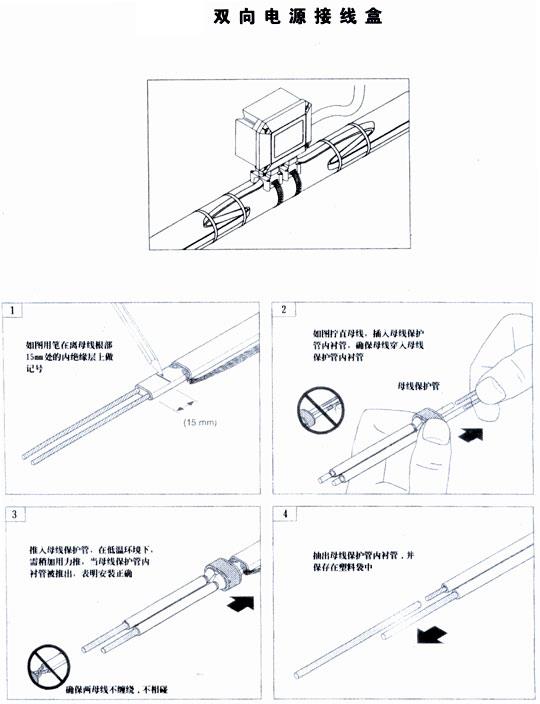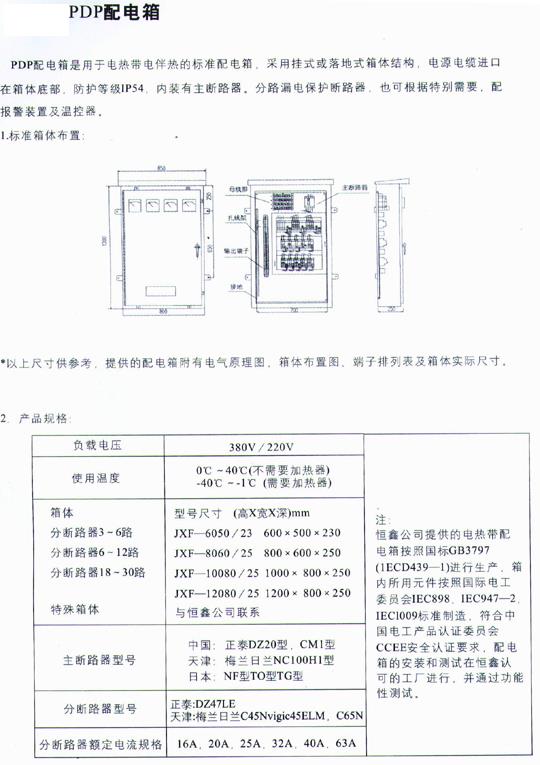Wuhu Hengxin Cable Co., Ltd
Contact:Mr Dai
Phone: 13955309088
Address: 13955309088@163.com
Address: Jiuhua North Road Electrical Components Industrial Park, Wuhu City, Anhui Province
| Chapter 1: Installation and Testing of Temperature Control Tracing Cables | |
(1) Design drawings Before construction, there should be a complete design drawing, which should include the following information: 1. The line number and power supply point are represented by rectangular grids. 2. The required electric heating belt model and length for the line. (Unit: meters) 3. The required length of electric heating strip per meter of pipeline length (unit: meter) is the winding coefficient 4. The required length of electric heating strip for each valve. (Unit: meters) 5. List of supporting materials and accessories for the heat tracing system. 6. List of accessories for temperature control system. 7. List of materials required for construction. 8. Design considering parameters and specifications of insulation materials used. (2) Preparation work before construction (A) Pipeline system 1. The pipeline system and equipment have been constructed. 2. The anti rust and anti-corrosion coating has dried completely. 3. The construction specifications for pipeline systems are consistent with those shown in the design drawings. 4. File off all burrs and sharp corners. (B) Electric heating belt and accessories 1. Is there any damage to the surface of the electric heating belt. 2. The insulation performance of the electric heating belt is good (the insulation resistance is required to be ≥ 20M Ω when tested with a shaking table at 1000VDC). 3. The model and design requirements of the electric heating belt and all accessories are consistent. (C) On site preparation 1. Place a coil of electric heating tape and a drum on a bracket and place them near one end of the line. 2. Install electric heating belts along the pipeline and avoid: *Place the electric heating belt on the burrs and sharp corners. *Pull the electric heating belt hard. *Place your foot or heavy object on the electric heating belt. (3) Construction method of single electric heating belt 1. Glass fiber pressure-sensitive tape or aluminum tape is used to fix the electric heating belt to the pipeline at intervals of about 50cm. 2. When applying flat, try to attach the electric heating tape to the lower 45 degree side of the pipe as much as possible. 3. Reserve a 1-meter-long electric heating belt at the first power supply point and the end of the line. 4. Route according to the design drawing with a winding coefficient (the coefficient is an integer and should be laid flat to reduce the number of joints). 5. All heat dissipation bodies (such as brackets, valves, flanges, etc.) should reserve the required length of electric heating belt according to the design drawings, wrap this section of electric heating belt around the heat dissipation body and fix it. The following points should be noted: *The heat dissipation body should have the length of the heating strip required for the design. *Electric heating belts can overlap or intersect with each other. *The winding method should be as easy as possible to remove the heat sink for maintenance or replacement at any time when necessary without damaging the heating belt or affecting other circuits. *When using two-way or three-way accessories, a 40cm length should be reserved at each end of the electric heating belt. (4) Spiral winding If the winding coefficient is 1.4, that is, a 5m pipeline needs to be equipped with a 7m electric heating belt. During construction, first fix both ends of the 7m long electric heating belt to a 5m long pipeline, then wrap the relaxed electric heating belt around the pipeline and fix it. (5) Construction method of multiple electric heating belts 1. The design drawing indicates a winding coefficient of (n=1, 2...), which is generally used on large-diameter pipelines. The method is as follows: *The electric heating belt is wired from one end of the pipeline to the end and then back to the starting point, with the route equal to the coefficient. (However, pay attention to using a longer length) *The number of times the electric heating belt is alternately wired from one end to the end of the pipeline is equal to the coefficient. *Backup system, critical pipelines are used for backup emergency purposes. So each line should be installed as an independent line and have an independent power supply point. | (6) Accessory installation *Select accessories according to the design requirements. *The sealing ring used should be compatible with the electric heating belt and combined with waterproof sealant. *The power supply junction box should be as close as possible to the power supply end of the pipeline line. *Prepare the cable outlet according to the accessory installation manual. *A small section of electric heating belt should be reserved at each end for future maintenance. (7) Inspection and testing before installation of insulation materials *Inspect the surface of the electric heating belt for any damage. *Check if all accessories are installed completely. *Use a 2500VDC shake meter to test one end of each independent circuit, and the insulation resistance should be above 20M Ω. Note that the shaking test time should be at least one minute, that is, the conductor should shake test the metal shielding layer of the electric heating belt. *Record the shaking test results on the installation record sheet. (8) Installation of insulation layer Immediately install the insulation layer after the electric heating belt construction test, and pay attention to the following points: *The material, thickness, and specifications of the insulation layer used comply with the requirements of the design drawings. *The insulation material must be dry during construction. *A waterproof cover should be added outside the insulation layer. *During the construction of the insulation layer, it is necessary to avoid damaging the heating belt. *After the construction of the insulation layer, the insulation test of the electric heating belt should be carried out immediately. *Warning labels should be added to the insulation layer to indicate that there is an electric heating belt inside, and the location of all accessories should also be noted. (9) Low temperature starting and safety protection: Electric heat tracing projects are generally started in groups according to the design drawings under normal conditions, and are operated under conventional control. They have switch start, overload protection, and leakage protection. If used for low-temperature high-power heating and starting in a low-temperature state, the instantaneous starting current can be converted into high-power output using a dual gate switching device, and the working current can be monitored during the switching process to transition to the overload protection system under safe load conditions. (10) Explosion proof: *Our company's explosion-proof electric heating belt can be used for explosion-proof situations in Zone 1 and Zone 2 of the factory. When installing, it should avoid dark corners where flammable and explosive gases or liquids accumulate, which may exceed the explosion-proof areas specified above. Non explosion-proof distribution boxes should be installed in non explosion-proof areas, otherwise corresponding explosion-proof distribution boxes should be configured. *In addition to the explosion-proof level, attention should be paid to the explosion-proof group. (11) Special precautions *It is strictly prohibited to mix steam tracing and electric tracing together. *When installing the heating strip, the insulation layer should not be damaged. It should be tightly attached to the heated object to improve thermal efficiency. If the heated object is a non-metallic body, aluminum adhesive tape should be used to increase the contact heat transfer area, and nylon ties should be used to fix it. It is strictly prohibited to tie it with metal wire. *The medium at the flange is prone to leakage, so when winding the electric heating belt, it should be avoided directly below it. *One end of the electric heating belt is connected to the power supply, and the other end of the wire core must not be short circuited or in contact with conductive substances and cut into a "V" shape. It must be tightly sealed with a matching head. *Explosion proof junction boxes and terminal blocks should be provided for fire and explosion prevention occasions. After wiring, silicone rubber sealing should be applied: (At the terminal of the electric heating belt using a shielding layer, the shielding layer must be peeled off by 10 centimeters to prevent short circuits) *Install a heat tracing point, measure the insulation once, the shielding layer must be grounded, and the insulation resistance should not be lower than 20 megohms/1000V. *Set the on/off and leakage protection devices according to the voltage, current and other parameters of each electric tracing circuit. *Steam cleaning: When steam cleaning is required to remove scale from pipelines, attention should be paid to cleaning first and then installing the electric heating belt. If the annual routine cleaning inspection is carried out, the installation should be designed according to special circumstances. (12) Acceptance: This manual does not include the construction and acceptance regulations for installation projects, as well as relevant provisions in the "Explosion proof and Fire Prevention Regulations". The above-mentioned technical specifications should still be followed during construction, and will not be repeated here. |





